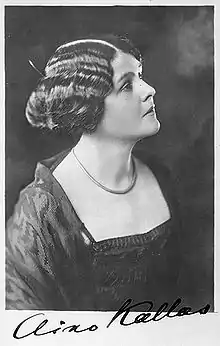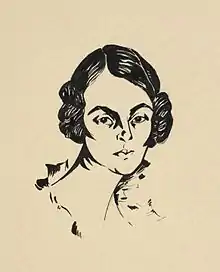Aino Kallas
Aino Krohn Kallas (2 August 1878 – 9 November 1956) was a Finnish-Estonian author. Her novellas are considered to be prominent pieces of Finnish literature.[1]
Aino Kallas | |
|---|---|
 Aino Kallas | |
| Born | 2 August 1878 Kiiskilä, Viipuri Province, Grand Duchy of Finland |
| Died | 9 November 1956 (aged 78) Helsinki, Finland |
| Nationality | Finnish |
| Spouse | Oskar Kallas |
| Children | 4 |
| Parents | Julius Krohn Maria "Minna" Wilhelmina Lindroos |
| Relatives | Aune Krohn (sister) Ilmari Krohn (half-brother) Kaarle Krohn (half-brother) Helmi Krohn (half-sister) Salme Setälä (niece) |
Life

Kallas was the daughter of Julius Krohn, a nationally known Finnish scientist and fennoman, and the sister of the folklorist Kaarle Krohn[1] and the writer Helmi Krohn. Her father was also one of the first people to publish poetry written in the Finnish language. In 1900, Kallas married Oskar Kallas, an Estonian scholar, doctor of folklore and later diplomat. The couple lived in Saint Petersburg and had five children. In 1904, they moved to Tartu, Estonia. Kallas became interested in the history and culture of her new homeland and she joined Noor-Eesti, a sociocultural society which campaigned for the independence of Estonia. Although she continued writing in Finnish, she often wrote about Estonian subjects.[1] She lived in London from 1922 to 1934, while her husband was Estonia's ambassador to the United Kingdom.[2] She published her diaries for the period 1897-1931 in the 1950s.

A recurring theme in Kallas's novellas is what she termed "the slaying Eros", a love that often leads to death, especially prominent in her trilogy of Barbara von Tisenhusen (1923), Reigin Pappi (The Pastor of Reigi, 1926), and Sudenmorsian (The Wolf's Bride, 1928).[3] The Pastor of Reigi and Barbara von Tisenhusen were soon translated into English and published in 1927 as Eros the Slayer. The language of her most famous story, Sudenmorsian, a werewolf story set in 17th century Hiiumaa, is rich with archaic, Romantic, colorful prose, something of a Kallas trademark.[3] These three stories have more recently been published in one English-language volume as Three Novels (1975). A collection of her short stories was published in English under the title The White Ship, with a foreword by John Galsworthy in 1924.
External links
- Petri Liukkonen. "Aino Kallas". Books and Writers
- Aino Kallas at IMDb
References
- The marriage of Aino and Oskar Kallas Archived 2016-01-02 at the Wayback Machine, Sirje Oleske, Estonian Literary Magazine, no 12, spring 2001, Retrieved 1 August 2016
- Sirje Olesk. The marriage of Aino and Oskar Kallas a Finnish bridge in reality, Estonian Literary Magazine, volume 12, 2001, ISSN 1406-0345 "Archived copy". Archived from the original on 2005-12-28. Retrieved 2005-08-10.CS1 maint: archived copy as title (link)
- Chantal Bourgault Du Coudray, The Curse of the Werewolf : Fantasy, Horror and the Beast Within. London: I.B. Tauris, 2006. ISBN 9781429462655 (p. 112, 169)